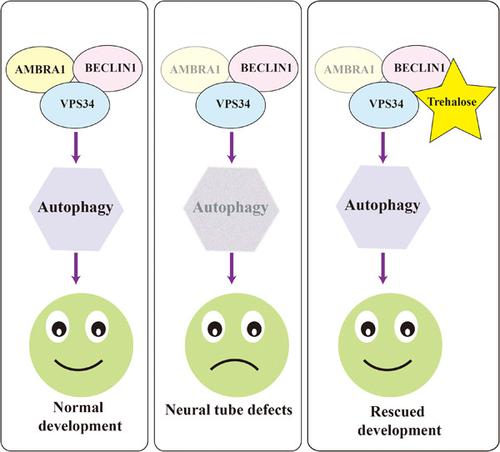当前位置:
X-MOL 学术
›
Hum. Mutat.
›
论文详情
Our official English website, www.x-mol.net, welcomes your
feedback! (Note: you will need to create a separate account there.)
Rare mutations in the autophagy-regulating gene AMBRA1 contribute to human neural tube defects.
Human Mutation ( IF 3.3 ) Pub Date : 2020-04-25 , DOI: 10.1002/humu.24028 Jianhong Ye 1, 2 , Youli Tong 2 , Jiashun Lv 2 , Rui Peng 3 , Shuxia Chen 2 , Lele Kuang 2, 4 , Ke Su 2 , Yufang Zheng 1, 3, 5 , Ting Zhang 6 , Feng Zhang 1, 3, 7 , Li Jin 2 , Xueyan Yang 2 , Hongyan Wang 1, 3, 7
Human Mutation ( IF 3.3 ) Pub Date : 2020-04-25 , DOI: 10.1002/humu.24028 Jianhong Ye 1, 2 , Youli Tong 2 , Jiashun Lv 2 , Rui Peng 3 , Shuxia Chen 2 , Lele Kuang 2, 4 , Ke Su 2 , Yufang Zheng 1, 3, 5 , Ting Zhang 6 , Feng Zhang 1, 3, 7 , Li Jin 2 , Xueyan Yang 2 , Hongyan Wang 1, 3, 7
Affiliation

|
Neural tube defects (NTDs) are severe congenital malformations caused by failed neural tube closure. Recently, autophagy is revealed to play a vital role in neuroepithelium development and neurulation. Autophagy and beclin 1 regulator 1 (Ambra1) is a crucial regulator of autophagy initiation, and its deficiency in mice leads to exencephaly and/or spina bifida. However, the genetic contribution of AMBRA1 to the etiology of human NTDs remains unknown. In this study, we identified five rare missense mutations of AMBRA1 in 352 NTDs cases, which were absent in 224 matched controls. Western blotting and fluorescence puncta counting for MAP1LC3A/LC3 in HEK293T cells suggested that four of the mutations (AMBRA1 p.Thr80Met, p.Leu274Phe, p.Ser743Phe, and p.Met884Val) affected autophagy initiation to various extents. Furthermore, these four mutations also displayed loss‐of‐function effects compared with wild‐type AMBRA1 when we injected messenger RNA (mRNA) to overexpress or rescue ambra1a‐morpholino oligos (MO) knockdown in zebrafish. It is intriguing that trehalose, a natural disaccharide, could rescue ambra1a‐ MO knockdown in a dose‐dependent manner independently or together with AMBRA1 mRNA. Taken together, our findings suggest that rare mutations of the autophagy regulator gene AMBRA1 may contribute to the etiology of human neural tube defects, and trehalose is a promising treatment for a subset of NTDs caused by autophagy impairment.
中文翻译:

自噬调节基因 AMBRA1 的罕见突变导致人类神经管缺陷。
神经管缺陷(NTD)是由神经管闭合失败引起的严重先天畸形。最近,发现自噬在神经上皮发育和神经形成中起着至关重要的作用。自噬和 beclin 1 调节因子 1 (Ambra1) 是自噬起始的关键调节因子,其在小鼠中的缺乏会导致无脑畸形和/或脊柱裂。然而,AMBRA1对人类 NTDs 病因的遗传贡献仍然未知。在这项研究中,我们确定了AMBRA1 的五个罕见错义突变在 352 个 NTD 病例中,在 224 个匹配的对照中不存在。HEK293T 细胞中 MAP1LC3A/LC3 的蛋白质印迹和荧光斑点计数表明,其中四个突变(AMBRA1 p.Thr80Met、p.Leu274Phe、p.Ser743Phe 和 p.Met884Val)在不同程度上影响自噬起始。此外,当我们注射信使 RNA (mRNA) 以在斑马鱼中过度表达或拯救ambra1a -吗啉代寡核苷酸 (MO) 敲低时,与野生型AMBRA1相比,这四种突变还显示出功能丧失效应。有趣的是,海藻糖是一种天然二糖,可以独立或与AMBRA1一起以剂量依赖性方式挽救ambra1a- MO 敲低mRNA。综上所述,我们的研究结果表明,自噬调节基因AMBRA1 的罕见突变可能导致人类神经管缺陷的病因,而海藻糖是治疗由自噬损伤引起的 NTD 子集的有希望的治疗方法。
更新日期:2020-04-25
中文翻译:

自噬调节基因 AMBRA1 的罕见突变导致人类神经管缺陷。
神经管缺陷(NTD)是由神经管闭合失败引起的严重先天畸形。最近,发现自噬在神经上皮发育和神经形成中起着至关重要的作用。自噬和 beclin 1 调节因子 1 (Ambra1) 是自噬起始的关键调节因子,其在小鼠中的缺乏会导致无脑畸形和/或脊柱裂。然而,AMBRA1对人类 NTDs 病因的遗传贡献仍然未知。在这项研究中,我们确定了AMBRA1 的五个罕见错义突变在 352 个 NTD 病例中,在 224 个匹配的对照中不存在。HEK293T 细胞中 MAP1LC3A/LC3 的蛋白质印迹和荧光斑点计数表明,其中四个突变(AMBRA1 p.Thr80Met、p.Leu274Phe、p.Ser743Phe 和 p.Met884Val)在不同程度上影响自噬起始。此外,当我们注射信使 RNA (mRNA) 以在斑马鱼中过度表达或拯救ambra1a -吗啉代寡核苷酸 (MO) 敲低时,与野生型AMBRA1相比,这四种突变还显示出功能丧失效应。有趣的是,海藻糖是一种天然二糖,可以独立或与AMBRA1一起以剂量依赖性方式挽救ambra1a- MO 敲低mRNA。综上所述,我们的研究结果表明,自噬调节基因AMBRA1 的罕见突变可能导致人类神经管缺陷的病因,而海藻糖是治疗由自噬损伤引起的 NTD 子集的有希望的治疗方法。











































 京公网安备 11010802027423号
京公网安备 11010802027423号